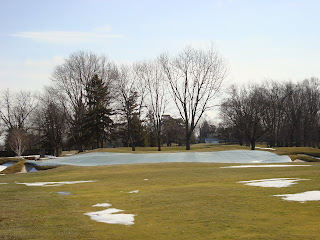

This week we were able to get back at some tree work on the golf course. Years ago there was a trend in golf that is referred to as backstopping. This is were blockades of trees were planted behind green sites to frame or define the site. There is a couple of issues with this practice, first and foremost these "screens" block air movement and sunlight from reaching playing surfaces. Secondly, they detract from the natural beauty of both the architecture and property. Typically coniferous trees were used for this task as they grow and fill in quickly. Behind our 8th green we have removed a screened planting of leaning, deteriorating cedars to open up the area. In the first picture you can see the cedars prior to removal, in the second you can see the more natural and open look and feel of the green site. Between the 8th green and the 12th tee we have now exposed three Maples that were hidden from view by the cedars. Once we are able to work the ground on the golf course we will be stripping, prepping and re sodding the area to improve both aesthetics and playability.
Comments
Post a Comment